English version: below
Sechs Monate nach Eröffnung des Flughafens BER in Schönefeld wird der Flughafen Tegel endgültig geschlossen. Nach aktuellem Planungsstand wird also ab Mai 2021 aus dem Flughafengelände im Norden Berlins eines der größten Stadtentwicklungsprojekte seit der Wiedervereinigung.
Auf dem Areal sollen in den folgenden Jahren ein Forschungs- und Industriepark für urbane Technologien (“Berlin TXL – The Urban Tech Republic”) sowie ein neues Wohnviertel (“Schumacher Quartier”) entstehen. Zudem wird ein etwa 200 Hektar großer Landschaftsraum entstehen. Mit der Entwicklung, Betreuung und Koordination dieses Stadtentwicklungsprojekts hat der Berliner Senat die Tegel Projekt GmbH beauftragt.
Landeseigenes Unternehmen: Tegel Projekt GmbH
Das landeseigene Unternehmen Tegel Projekt GmbH beschäftigt rund 50 Mitarbeiter*innen. Sie befassen sich mit der Aus- und Überarbeitung des geltenden Masterplans, der Markenentwicklung, den Planungen für den Hochbau und die technische, energetische und verkehrliche Infrastruktur des Geländes.
Darüber hinaus ist das Unternehmen mit der Vertriebsvorbereitung und der Kommunikation des Projektes in der Öffentlichkeit betraut.
Zwei Projekte werden parallel entwickelt
Auf dem riesigen Gelände sollen zwei Projekte parallel entwickelt werden. In der „Urban Tech Republic“ werden bis zu 1.000 große und kleinere Unternehmen mit 20.000 Beschäftigten forschen, entwickeln und produzieren. Mehr als 2.500 Studierende werden zudem mit der renommierten Beuth Hochschule in das ehemalige Terminalgebäude (genauer: Terminal A) einziehen.
In der Nachbarschaft wird das Schumacher Quartier mit über 5.000 Wohnungen für mehr als 10.000 Menschen entstehen. Hier soll ein lebendiges, städtisches Quartier mit Kitas, Schulen und Einkaufsmöglichkeiten entwickelt werden.
Der Technologie Park: “Urban Tech Republic”
Unter dem Namen „Berlin TXL – The Urban Tech Republic“ wird auf einer Größe von rund 211 Hektar ein Forschungs- und Industriepark für urbane Technologien entstehen. Im Klartext heißt das, das auf dem riesigen Gelände Flächen für Industrie, Gewerbe und Wissenschaft entstehen sollen.
Im Fokus des Innovationsparks sollen urbane Technologien für die wachsenden Metropolen des 21. Jahrhunderts stehen. Neue Technologien sollen zukünftig erforscht, entwickelt, produziert, getestet und auch exportiert werden.
Im Fokus: Urbane Technologien des 21. Jahrhunderts
Wissenschaft, Forschung, Industrie und Gewerbe sollen zukünftig gemeinsam an Lösungen für die Organisation und das Zusammenleben in urbanen Räumen arbeiten und sich natürlich auch mit potenziellen Investoren austauschen können.
Sechs Schwerpunktthemen wurden vom Projektentwickler definiert:
- Klimaneutrale Energiesysteme und effizienter Energieeinsatz
- Umweltschonende Mobilität
- Sauberes Wasser
- Recycling
- Einsatz neuer Materialien für Anwendungen wie nachhaltiges Bauen
- Die vernetzte Steuerung von Systemen
Baubeginn im Herbst 2021: Potenzial für 20.000 Arbeitsplätze
Baubeginn für die öffentliche Erschließung des Areals soll unmittelbar nach Übernahme des Geländes sein, die zwischen Mai und August 2021 erfolgen soll. Geplant ist, das Gelände im Sommer 2021 für alle Berliner*innen an einem Tag der offenen Tür zugänglich zu machen, bevor es ab Herbst 2021 für mehrere Jahre zur Großbaustelle wird.
Die Erschließung des gesamten Areals ist langfristig angelegt. In vier Bauabschnitten soll das Gelände bis 2040 entwickelt werden. Bis zu 5.000 Studierende und bis zu 20.000 Menschen sollen hier einmal lernen, forschen und arbeiten. Es sollen Flächen und Räumlichkeiten für die Ansiedlung von etwa 1.000 Unternehmen geschaffen werden.
Das Schumacher Quartier
Am westlichen Rand des Kurt-Schumacher-Platzes wird ein völlig neues Wohnviertel entstehen. Auf dem östlichen Teil des Rollfelds des Flughafens (und darüber hinaus) plant die Tegel Projekt GmbH über 5.000 Wohnungen für mehr als 10.000 Menschen. Auch die dazugehörigen Einrichtungen wie Schulen, Kitas, Sportanlagen und Einkaufsmöglichkeiten sollen geschaffen werden. Dabei soll es gleichzeitig ein grünes und soziales Viertel mit bezahlbaren Mieten und viel Raum für Freizeit und Erholung werden.
5.000 Wohnungen für 10.000 Menschen
Das Quartier ist nach dem Willen der Projektplaner als nachhaltiges und sozial gemischtes Wohnareal konzipiert und soll somit einen wichtigen Beitrag zur Wohnungsbau- und Stadtentwicklungsstrategie Berlins leisten. Insgesamt soll eine Fläche von rund 48 Hektar bebaut werden. 29 davon liegen auf dem Gebiet des heutigen Rollfeldes.
Weitere 4.000 Wohnungen sollen in den benachbarten Wohngebieten Cité Pasteur und TXL Nord entstehen.
Landeseigene Mietwohnungen sollen entstehen
Auf dem Areal sollen vorwiegend Mietwohnungen entstehen. Hierfür werden, nach aktuellem Planungsstand, die landeseigenen Wohnungsbaugesellschaften DEGEWO, GESOBAU und GEWOBAG mit in das Projekt involviert. Außerdem können Baugruppen und Genossenschaften hier Wohnhäuser bauen.
Auf einem sogenannten “Bildungscampus” sollen zwei Schulen und mehrere Sport- und Jugendeinrichtungen errichtet werden. Insgesamt sechs Kitas sollen auf dem gesamten Wohnareal entstehen.
“Smart City” Schumacher Quartier
Durch die Nähe zum Technologie Park soll das Wohngebiet von den neuesten Forschungsentwicklungen profitieren. Viele der dort entwickelten Technologien sollen zukünftig im Schumacher Quartier getestet und angewandt werden.
Das Wohnviertel ist von vornherein als “Smart City” konzipiert: Klimaneutrale und wassersensitive Stadtentwicklung, alternative Baustoffe und ein innovatives Energiekonzept sollen bei der Entwicklung des Areals im Fokus stehen. Zudem soll das Quartier autofrei und mit eigenen Radwegen, Radschnellwegen sowie Mobilitäts-Hubs mit vielfältigen, umweltschonenden Mobilitätsangeboten angelegt werden.
Die Nachnutzung Tegels: Eine historische Chance für Berlin
Die anstehende Entwicklung des Flughafenareals im Norden der Hauptstadt sollte als historische Chance verstanden werden. Die “Urban Tech Republic” und das “Schumacher Quartier” können zu einem Vorbild für die Stadtentwicklung der Zukunft avancieren, und das nicht nur in Deutschland, sondern im globalen Kontext. Es wird sehr spannend sein, die ambitionierten Pläne in ihrer Umsetzung zu begleiten.
© Grafiken: Tegel Projekt GmbH
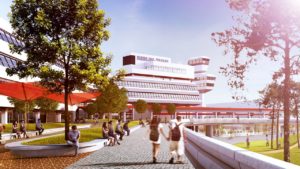 Raum für Studierende: Im Terminal A des ehemaligen Flughafens wird die Beuth-Hochschule einziehen.
Raum für Studierende: Im Terminal A des ehemaligen Flughafens wird die Beuth-Hochschule einziehen.
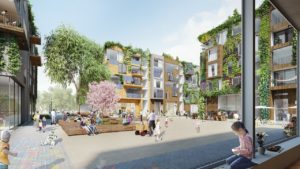 “Schumacher Quartier”: Klimaneutrales Wohnquartier für 10.000 Menschen
“Schumacher Quartier”: Klimaneutrales Wohnquartier für 10.000 Menschen
Six months after the opening of BER Airport in Schönefeld, Tegel Airport will be closed for good. According to current planning, in May 2021 the airport site in the north of Berlin will become one of the largest urban development projects since German reunification.
In the following years, a research and industrial park for urban technologies (“Berlin TXL – The Urban Tech Republic”) and a new residential area (“Schumacher Quartier”) are to be built on the site. In addition, a landscape area of about 200 hectares will be created. The Berlin Senate has commissioned Tegel Projekt GmbH with the development, supervision and coordination of this urban development project.
STATE-OWNED COMPANY: TEGEL PROJEKT GMBH
The state-owned company Tegel Projekt GmbH employs around 50 people. They deal with the development and revision of the current master plan, brand development, planning for structural engineering and the technical, energy and traffic infrastructure of the site.
In addition, the company is also entrusted with the preparation of sales and the communication of the project to the public.
TWO PROJECTS ARE BEING DEVELOPED IN PARALLEL
Two projects will be developed in parallel on the huge site. In the “Urban Tech Republic”, up to 1,000 large and small companies with 20,000 employees will research, develop and produce. More than 2,500 students will also move into the former terminal building (more precisely: Terminal A) together with the renowned Beuth University of Applied Sciences.
The Schumacher Quartier with more than 5,000 apartments for more than 10,000 people will be built in the neighborhood. A lively, urban quarter with daycare centers, schools and shopping facilities is to be developed here.
THE TECHNOLOGY PARK: “URBAN TECH REPUBLIC
Under the name “Berlin TXL – The Urban Tech Republic”, a research and industrial park for urban technologies will be created on an area of around 211 hectares. In plain language, this means that areas for industry, commerce and science are to be created on the huge site.
The innovation park will focus on urban technologies for the growing metropolises of the 21st century. New technologies are to be researched, developed, produced, tested and exported in the future.
IN FOCUS: URBAN TECHNOLOGIES OF THE 21ST CENTURY
In the future, science, research, industry and commerce are to work together on solutions for organization and living together in urban areas and, of course, be able to exchange ideas with potential investors.
The project developer has defined six main topics:
- Climate-neutral energy systems and efficient energy use
- Environmentally friendly mobility
- Clean water
- Recycling
- Use of new materials for applications such as sustainable construction
- The networked control of systems
CONSTRUCTION STARTS IN AUTUMN 2021: POTENTIAL FOR 20,000 JOBS
Construction for the public development of the area is to begin immediately after the takeover of the site, which is scheduled to take place between May and August 2021. It is planned to make the site accessible to all Berliners* on an open day in the summer of 2021, before it becomes a major construction site for several years starting in the fall of 2021.
The development of the entire area is planned for the long term. The site is to be developed in four construction phases until 2040. Up to 5,000 students and up to 20,000 people are to learn, research and work here one day. Areas and premises are to be created for the settlement of about 1,000 companies.
THE “SCHUMACHER QUARTiER”
On the western edge of Kurt-Schumacher-Platz a completely new residential area will be created. On the eastern part of the airport tarmac (and beyond) Tegel Projekt GmbH is planning more than 5,000 apartments for more than 10,000 people. The associated facilities such as schools, daycare centers, sports facilities and shopping facilities are also to be created. At the same time, it is intended to be a green and social district with affordable rents and plenty of space for leisure and recreation.
5.000 APARTMENTS FOR 10.000 PEOPLE
According to the project planners, the neighborhood is designed as a sustainable and socially mixed residential area and should thus make an important contribution to Berlin’s housing and urban development strategy. A total area of around 48 hectares is to be built on. 29 of these are located in the area of the current runway.
Another 4,000 apartments are to be built in the neighboring residential areas Cité Pasteur and TXL Nord.
STATE-OWNED RENTAL APARTMENTS TO BE BUILT
The area will be used primarily for rental apartments. According to the current planning status, the state-owned housing companies DEGEWO, GESOBAU and GEWOBAG will be involved in the project. In addition, building groups and cooperatives can build residential buildings here.
Two schools and several sports and youth facilities are to be built on a so-called “education campus”. A total of six daycare centers are to be built on the entire residential area.
“SMART CITY” SCHUMACHER QUARTER
Due to the proximity to the Technology Park, the residential area will benefit from the latest research developments. Many of the technologies developed there are to be tested and applied in the Schumacher Quartier in the future.
The residential area is designed as a “Smart City” from the outset: Climate-neutral and water-sensitive urban development, alternative building materials and an innovative energy concept are to be the focus of the area’s development. In addition, the quarter is to be car-free and will have its own cycle paths, cycle expressways and mobility hubs offering a wide range of environmentally friendly mobility options.
THE SUBSEQUENT USE OF TEGEL: A HISTORIC OPPORTUNITY FOR BERLIN
The upcoming development of the airport area in the north of the capital should be seen as a historical opportunity. The “Urban Tech Republic” and the “Schumacher Quartier” can become a model for the urban development of the future, not only in Germany but also in the global context. It will be very exciting to accompany the ambitious plans in their implementation.
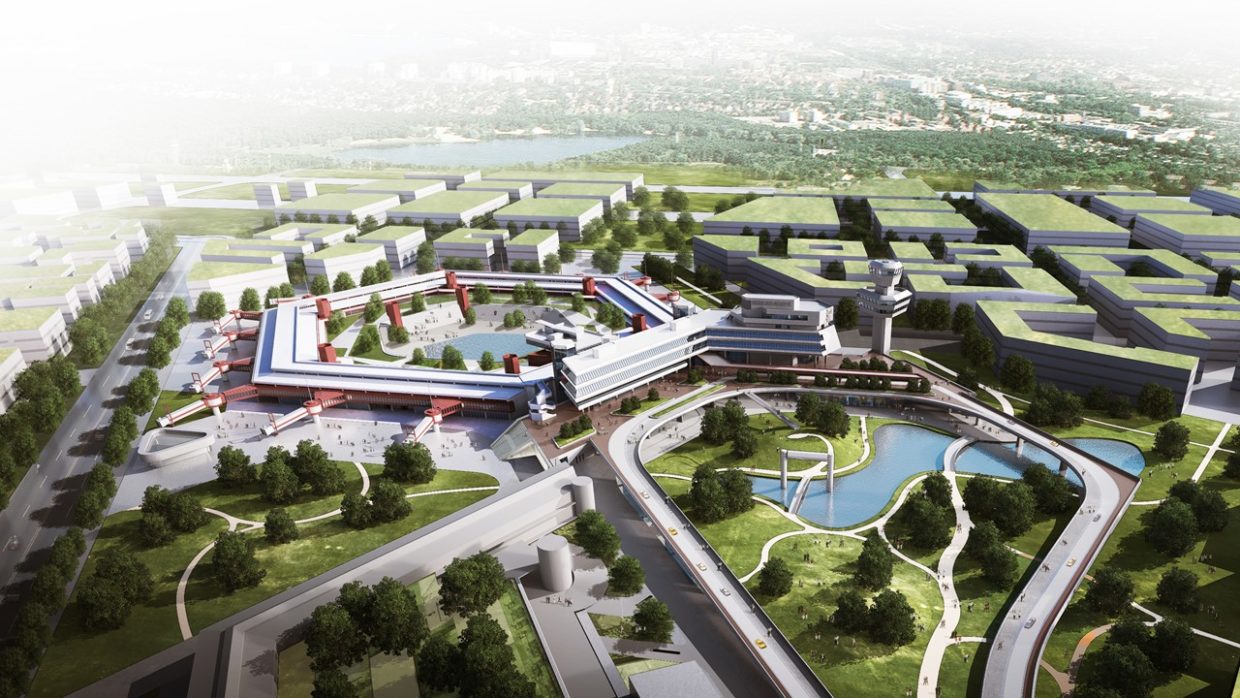
 Das Projekt aus der Luft: “Urban Tech Republic”, “Schumacher Quartier” und neue Landschaftsflächen werden entstehen.
Das Projekt aus der Luft: “Urban Tech Republic”, “Schumacher Quartier” und neue Landschaftsflächen werden entstehen.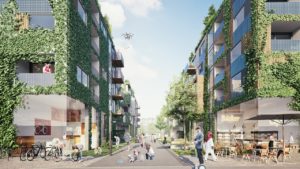 Bezahlbarer Wohnraum und innovative Technologien: Das sind die Pläne für das Wohnquartier auf dem ehemaligen Rollfeld des Flughafens.
Bezahlbarer Wohnraum und innovative Technologien: Das sind die Pläne für das Wohnquartier auf dem ehemaligen Rollfeld des Flughafens.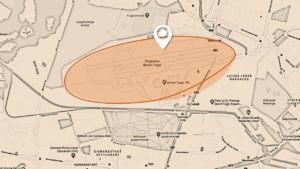
9 Pingbacks